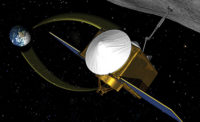Test Chamber Proves a Sound Solution for Whirlpool

Whirlpool Corp. engineers use two anechoic chambers to measure sound produced by appliances and appliance components. Photo courtesy Eckel Industries Inc.

Each anechoic chamber is large enough to accommodate any Whirlpool product—from a toaster to a refrigerator. Photo courtesy Eckel Industries Inc.


Few things in a home are as annoying as a noisy appliance. No one knows this better than Whirlpool Corp., the world’s No. 1 manufacturer of kitchen and laundry appliances, such as dishwashers and clothes dryers.
For many decades, the company has performed basic sound and vibration testing on each type of appliance prior to and during production. Ever-changing industry noise standards, however, required the company to upgrade the sound lab at its Benton Harbor (MI) Technology Center last year.
With the help of two new anechoic (without echo) chambers, engineers there perform overall-machine and component-specific tests. Data obtained from these tests enable the engineers to adjust their designs accordingly and minimize the noise and vibration emitted by any Whirlpool product.
Madison, WI-based ACS designed and built the test facility, while Eckel Industries Inc. supplied the chambers. Both chambers required customization to offset external vibrations generated by a nearby railroad track and to accommodate special lighting requirements, says Ron Ingham, lead engineer at the technology center sound lab for Whirlpool.
Each chamber is large enough to accommodate any Whirlpool product— from a standard toaster, to a large refrigerator. One chamber has dryer venting, a natural gas inlet, hot and cold water, and an isolated drain. The other chamber has cold water and a drain.
Both chambers also feature a solid plane that provides a surface similar to a kitchen wall. This wall is easily disassembled to transform the space from a semi-anechoic (with conductive floor) chamber into a hemi-anechoic (floor has no acoustical treatment) chamber for component testing.
Internally, each chamber measures 21 feet, by 16 feet, 7 inches, and is 13 feet, 10 inches high. It has a 5-foot-4-inch-by-8-foot-8-inch combination sound and wedge door, and a spring-isolated concrete floor. The walls, ceiling and door are covered with anechoic perforated metal wedges.
To allow for discrimination of low-level radiated sounds, the chamber has a 100-hertz cutoff frequency and a maximum background noise level of 10 decibels (about the level of normal breathing). It meets IEC 60704 test standards and ISO 3745 Annex A qualifications.
“These two precision-grade sound chambers will help [us] gain and maintain market standing with respect to sound performance,” says Ingham. “Future advances will [result in] quieter components [and] overall sound levels, which will increase customer satisfaction.”
Headquartered in Cambridge, MA, Eckel helped create the world’s first anechoic chamber at Harvard University in 1943. The American National Defense Research Committee performed research there to investigate sound in combat vehicles.
Since then, Eckel has designed test chambers for products ranging from cell phones, to cars, to jet engines.
For more information on hemi- or full-anechoic chambers, call 617-491-3221 or visit www.eckelusa.com.
Looking for a reprint of this article?
From high-res PDFs to custom plaques, order your copy today!








